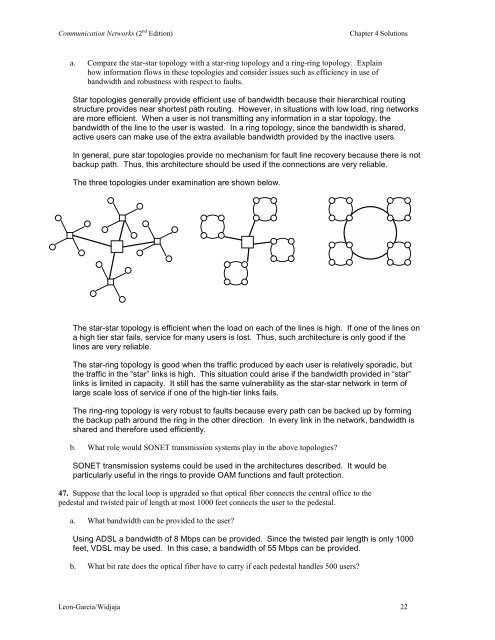Solutions to Chapter 4 - Communication Networks
Solutions to Chapter 4 - Communication Networks
Solutions to Chapter 4 - Communication Networks
Create successful ePaper yourself
Turn your PDF publications into a flip-book with our unique Google optimized e-Paper software.
<strong>Communication</strong> <strong>Networks</strong> (2 nd Edition)<br />
<strong>Chapter</strong> 4 <strong>Solutions</strong><br />
a. Compare the star-star <strong>to</strong>pology with a star-ring <strong>to</strong>pology and a ring-ring <strong>to</strong>pology. Explain<br />
how information flows in these <strong>to</strong>pologies and consider issues such as efficiency in use of<br />
bandwidth and robustness with respect <strong>to</strong> faults.<br />
Star <strong>to</strong>pologies generally provide efficient use of bandwidth because their hierarchical routing<br />
structure provides near shortest path routing. However, in situations with low load, ring networks<br />
are more efficient. When a user is not transmitting any information in a star <strong>to</strong>pology, the<br />
bandwidth of the line <strong>to</strong> the user is wasted. In a ring <strong>to</strong>pology, since the bandwidth is shared,<br />
active users can make use of the extra available bandwidth provided by the inactive users.<br />
In general, pure star <strong>to</strong>pologies provide no mechanism for fault line recovery because there is not<br />
backup path. Thus, this architecture should be used if the connections are very reliable.<br />
The three <strong>to</strong>pologies under examination are shown below.<br />
The star-star <strong>to</strong>pology is efficient when the load on each of the lines is high. If one of the lines on<br />
a high tier star fails, service for many users is lost. Thus, such architecture is only good if the<br />
lines are very reliable.<br />
The star-ring <strong>to</strong>pology is good when the traffic produced by each user is relatively sporadic, but<br />
the traffic in the “star” links is high. This situation could arise if the bandwidth provided in “star”<br />
links is limited in capacity. It still has the same vulnerability as the star-star network in term of<br />
large scale loss of service if one of the high-tier links fails.<br />
The ring-ring <strong>to</strong>pology is very robust <strong>to</strong> faults because every path can be backed up by forming<br />
the backup path around the ring in the other direction. In every link in the network, bandwidth is<br />
shared and therefore used efficiently.<br />
b. What role would SONET transmission systems play in the above <strong>to</strong>pologies<br />
SONET transmission systems could be used in the architectures described. It would be<br />
particularly useful in the rings <strong>to</strong> provide OAM functions and fault protection.<br />
47. Suppose that the local loop is upgraded so that optical fiber connects the central office <strong>to</strong> the<br />
pedestal and twisted pair of length at most 1000 feet connects the user <strong>to</strong> the pedestal.<br />
a. What bandwidth can be provided <strong>to</strong> the user<br />
Using ADSL a bandwidth of 8 Mbps can be provided. Since the twisted pair length is only 1000<br />
feet, VDSL may be used. In this case, a bandwidth of 55 Mbps can be provided.<br />
b. What bit rate does the optical fiber have <strong>to</strong> carry if each pedestal handles 500 users<br />
Leon-Garcia/Widjaja 22







